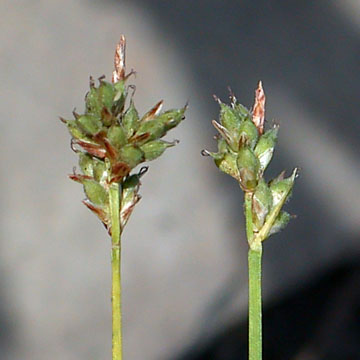

Carex peckii - (image 1 of 4)
Taxonomy
Family: Cyperaceae
Section Acrocystis
Habitat
Open woods, mainly on calcareous soils.
Associates
Distribution
Quebec to Yukon, south to NJ, MI, MN, NE, and British Columbia.
Morphology
Loosely tufted perennial; stems slender, erect, 20-60 cm, typically much surpassing the leaves; leaves 1-1.5 mm wide; inflorescence 1-2 cm with a small terminal staminate spike and 2-3 closely crowded pistillate ones; pistillate scales reddish-brown with a broad hyaline margin and pale center, wider but shorter than the perigynia, blunt or rounded, sometimes shortly mucronate; perigynia 3-12, dull- to yellowish-green, short-hairy, 2.7-4.1 mm, slightly flattened, narrowly obovoid above a stipe-like base, 2-keeled, abruptly contracted to a slender beak 0.5 mm; achene rounded-trigonous.
Notes
Fruiting mid May to early July
Wetland indicator: NA
Differs from C. albicans and similar species in that the pistillate scales are noticeable shorter than the perigynia. Can be distinguished from C. deflexa by the larger perigynia (3.2-4.2 mm long vs. 2.3-3.1 mm long), and the longer and more robust culms that exceed the leaves (vs. culms equaling or shorter than the leaves).
References
Ball, P.W. and A.A. Reznicek. 2002. Carex, In: Flora of North America Editorial Committee, Eds. Flora of North America North of Mexico. Volume 23. Oxford University Press, New York.
Gleason, Henry A. and A. Cronquist. 1991. Manual of Vascular Plants of
Northeastern United States and Adjacent Canada. Second Ed.
The New York Botanical Garden. Bronx, NY
|
© Michael Hough 2018 |